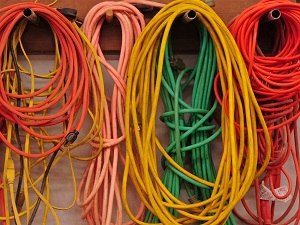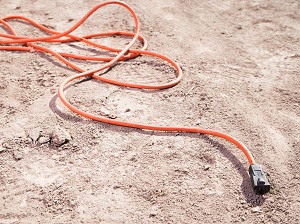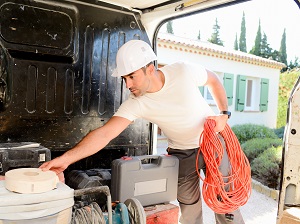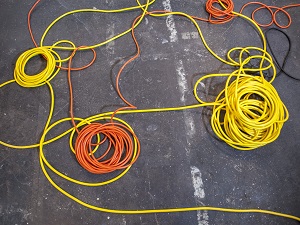If you think safety reminders about how to use an extension cord seem ridiculous, think again. Stop making assumptions and make sure everyone on your team is getting trained on electrical safety...even the basics need to be covered.

Electrical hazards are an area of major safety concern in construction and account for a large number of injuries and fatalities. Even workers that aren't electricians are going to be using electricity every day to do their job, and something as seemingly harmless as an extension cord has it's own hazards. Extension cords can be found on any construction site and reminding crews about safe use of extension cords is as important as safety training on electrical tool use.
OSHA Construction Standard 1926.416(a)(1) states that no employer shall permit an employee to work in such proximity to any part of an electric power circuit that the employee could contact the electric power circuit in the course of work, unless the employee is protected against electric shock by deenergizing the circuit and grounding it or by guarding it effectively by insulation or other means.

In addition, office buildings, warehouses, and manufacturing plants are corporate and industrial environments where electrical equipment and outlets will definitely be found and can pose unique hazards to employees who work there.
Cable protectors offer a quick solution to protect cables and hoses from pedestrian and vehicle traffic. Consider light- to medium-duty cable protectors to prevent trip hazards in an office or warehouse, while heavy-duty cable protectors might be a better choice on job sites with construction equipment or heavy pedestrian traffic.
OSHA General Industry Standard 1910.333(a) states that safety-related work practices shall be employed to prevent electric shock or other injuries resulting from either direct or indirect electrical contacts, when work is performed near or on equipment or circuits which are or may be energized. The specific safety-related work practices shall be consistent with the nature and extent of the associated electrical hazards.
No one should take electricity for granted. No matter how small the task, how temporary the project or how trained the staff, everyone should be using safe work practices, especially when using electrical tools and equipment.

OSHA Construction Standard 1926.405(a)(2)(ii)(j) Extension cord sets used with portable electric tools and appliances shall be of three-wire type and shall be designed for hard or extra-hard usage. Flexible cords used with temporary and portable lights shall be designed for hard or extra-hard usage. … Some examples include types SJ, SJO, SJT, SJTO.
Extension cords should be selected carefully and be approved by a laboratory such as Underwriters Laboratory (UL).
OSHA General Industry Standard 1910.334(a)(2)(i) Portable cord and plug connected equipment and flexible cord sets (extension cords) shall be visually inspected before use on any shift for external defects (such as loose parts, deformed and missing pins, or damage to outer jacket or insulation) and for evidence of possible internal damage (such as pinched or crushed outer jacket). Cord and plug connected equipment and flexible cord sets (extension cords) which remain connected once they are put in place and are not exposed to damage need not be visually inspected until they are relocated.

During the weekly safety meeting or morning safety huddle on electrical safety, the following tips on safe use of extension cords should be discussed:
- Always inspect your electrical tools and extension cords before use.
- Don't use an extension cord that is wet and never plug an extension cord into an electrical device with wet hands.
- Never unplug an extension cord by pulling on the cord; pull on the plug only.
- Never use extension cords that have broken or missing ground pins - those are there for your safety!
- Use only properly rated extension cords for a construction site and UL (or similarly) approved extension cords for use in all work environments.
- Never run cords through windows or doors where they could be pinched or damaged.
- Ensure extension cords are kept out of walkways to avoid potential trip and fall hazards.
- Remove frayed, damaged, or severely kinked extension cords from use immediately.
OSHA General Industry Standard 1910.334(a)(5)(i) Employees' hands may not be wet when plugging and unplugging flexible cords and cord and plug connected equipment, if energized equipment is involved.
OSHA Construction Standard 1926.405(a)(2)(ii)(l) Flexible cords and cables shall be protected from damage. Sharp corners and projections shall be avoided. Flexible cords and cables may pass through doorways or other pinch points, if protection is provided to avoid damage.

.jpeg)

